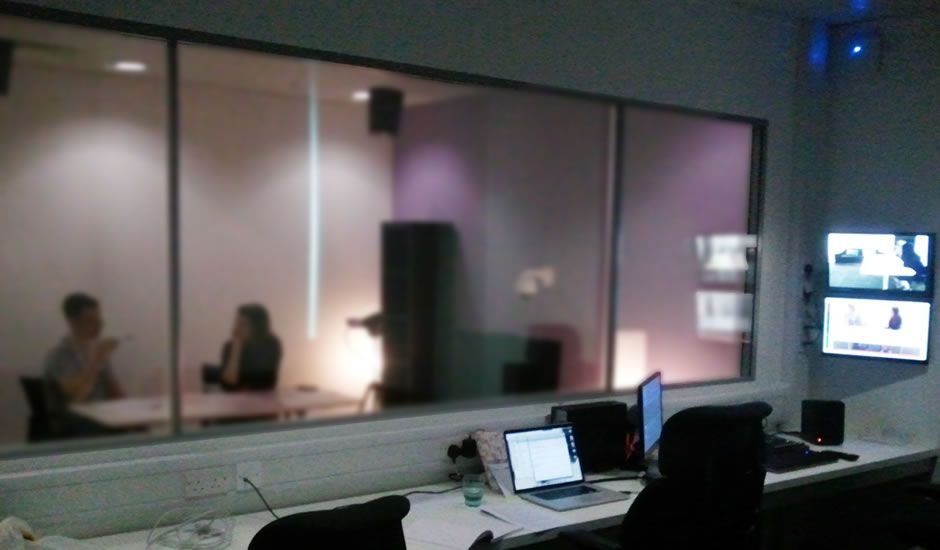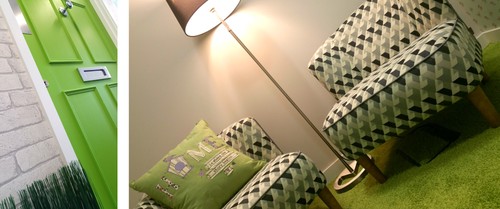Why you shouldn’t use one way mirrors for UX Research

Do you use one way mirror labs? Do you value research that gets you the best results? Then you might want to re-consider using one way mirrors. Here’s why…
Talking to users is fascinating! It’s something we absolutely love doing despite having conducted thousands of them! When it comes to location, you can test almost anywhere but there’s one place that we advise against, and that’s one way mirror labs.
What is a one way mirror lab?
A one way mirror lab (also known as two way) consists of two adjoining rooms with a mirror between them. One room is used to interview people and the mirror functions as a normal mirror from this side. On the other side of the mirror is the observation room where people watch the research taking place, from this side the mirror behaves as a window, enabling the observers to secretly observe what’s happening in the research room.
The negative consequences for research
We’ve used this setup many times and sat on both sides of the mirror. These are the problems:
Nervous users
As a researcher you are ethically bound to tell the participant that there are observers behind the mirror. However, there is a problem with this and it’s called the Ironic Process Theory or the White Bear Principle. It refers to the human tendency to continue to think about something after being told not to think about it. For example, if someone says to you ‘don’t think about a pink elephant’, it’s the first thing you’ll picture in your head.
Many users will forget about the mirror. There are other users who will interview ok but afterwards they will admit to feeling watched (which in turn will have influenced their answers). Finally, some people simply do not interview well with one way mirrors. They may appear nervous, glance at the mirror throughout, whisper some answers to you because they don’t want the people behind the mirror to hear any negative feedback, etc. And the mirror is a difficult thing for people to get over once they have a problem with it, because it’s such a huge object in the room and therefore a constant reminder.
Positively biased responses
If you knew there were a group of people watching you behind a mirror wouldn’t you be more inclined to give positive responses and to withhold negative opinions? It’s natural for people to do this, particularly if they are new to research – they’ll be inclined to want to please you.
Sound leakage
Your observers need to be relatively quiet. I’ve seen labs provide headphones so that observers can turn audio volume up without sound leaking into the testing suite.
When two rooms are next to each other, it’s impossible to soundproof them completely. If the observers next door get quite loud, or turn the volume up, the sound can leak into the adjoining room. Imagine if they laugh and the user hears this (yes this has happened). In some labs, the doors don’t close quietly either – this then becomes another reminder to the participant that there are people watching them.
Noisy cameras
One way mirror labs almost always have cameras that can be controlled in the observation room. These aren’t always silent though. You can be in the middle of a really interesting insight with the participant opening up to you, when all of a sudden you hear the dreaded buzz of the camera . Off-putting to say the least and yet another reminder to the user that they are being watched.
Dark, uninspiring observation room where no one speaks
Observation rooms in labs are awful places really. There are no windows and therefore no natural light, the lights have to be turned off (otherwise you can see straight through the mirror) so it’s a dark, dull, uninspiring room to be sat in all day. In one way mirror labs sometimes the observers can be much quieter than in labs without a mirror, because they can see how close the participant is to them. This isn’t conducive to team working and problem solving.
The issue is these are great setups for observing research, especially focus groups, not UX research. If you have a team of designers observing research, the one thing they’re guaranteed to want to do is sketch, but how do they do that well when they’re sat in a dark room? It’s not an environment that encourages team collaboration, makes a team feel energised, inspired and creative. Conversation and teamworking should be encouraged – now’s the perfect time for the team to get together in one place, collaborate and get to work on designs.
Ironically, no one really observes what’s happening through the mirror!
We spend most of our time watching the TV screens, which give us consistent detail, clarity and control. The glass, for all its glamour, doesn’t always fulfil its worth.
In UX research, the most important interaction to focus on is that between the user and what’s being tested, and in this regard you can’t see anything through the mirror, the detail is through the cameras pointing at what the user is doing. Therefore, the majority of the time, observers are focussed on the tv screen – where the action is. Compare it to UX design…if you want the users attention to focus on something you might give it a more central position, make it bigger, put everything else around it. So when the UI is the most important thing for people to observe, why do labs show this on a small tv screen and give the highest visual prominence in the room to the mirror? It’s crazy!
The solution
The alternative, better solution is to use two rooms that have all the same technology to record and observe the user and their interaction but in the observation room, there are TV screens and no mirror. GDS (Government Digital Services) also use this setup which you can see here. Without a mirror, you’ll get better insights from your more relaxed users and the observation room can now be a creative haven. You can turn up the lights, have natural daylight (windows), have dynamic team discussions and work together on sketches and ideas.
It suddenly becomes an exciting and inspiring workshop to turn user feedback into better designs! And this, is the whole purpose of user research.
We built our own pioneering homely research lab
At Keep It Usable, we’ve designed our own lab from the ground up. We understand the importance of a natural environment to get the best out of user research / usability testing, somewhere that is comfortable and cosy, as if the user were in their natural setting at home.
Meet Home UX Lab
We’ve pioneered the home style UX lab – our Home UX Lab has a living room design and cosy, relaxed feel to put people at ease and gather deeper insights so you get more value from your research.
Read about the amazing Home UX Lab.
Need help or advice?
If you’d like to know more about our pioneering Home UX Lab and how it can help you, contact our UX experts for free, friendly, no-ties advice.
Other posts you may find interesting:
Share this post:
